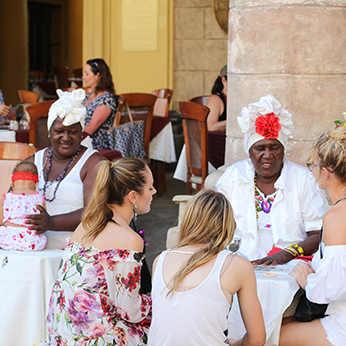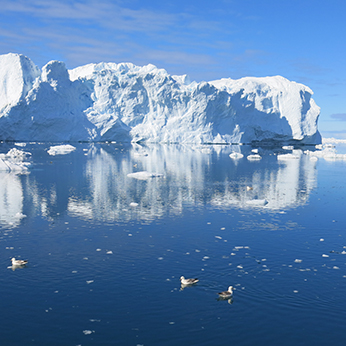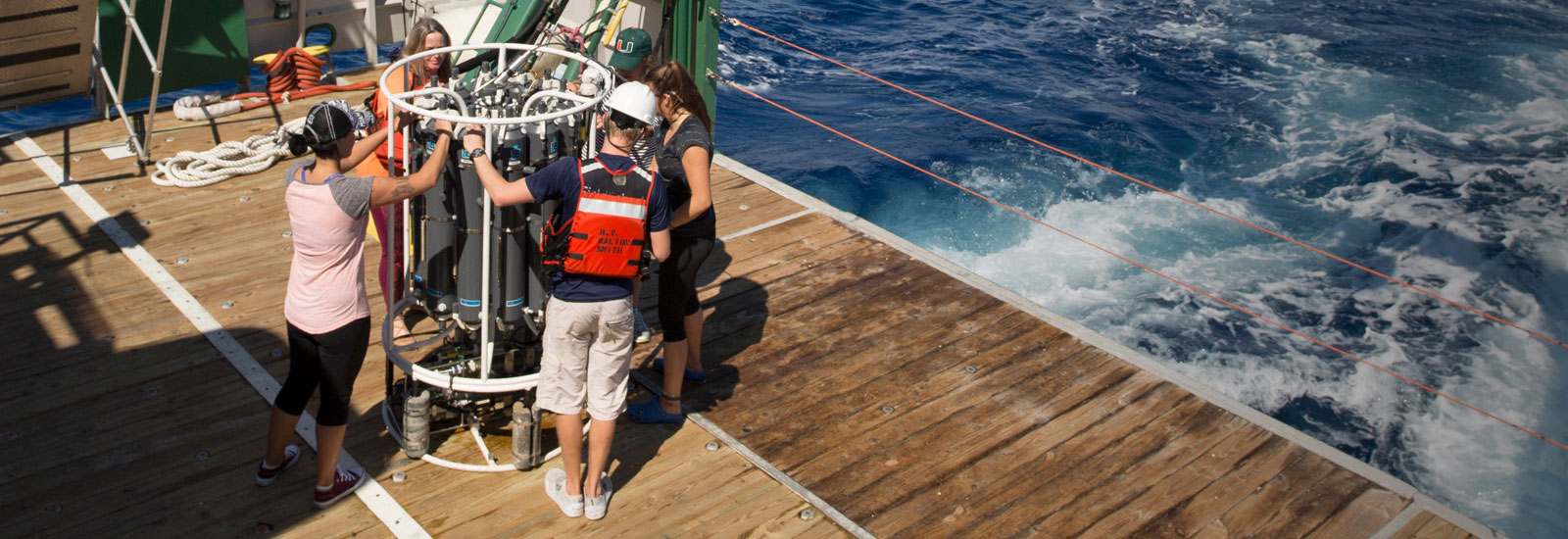
Gazing down into the cobalt blue water, the researchers, students and guests were hypnotized by the sea. They stood transfixed, partly to restrain their seasickness—sailing through 6-foot waves—but mostly to revel in their spirited encounter with a pod of dolphins.
Scientist Andriana “Andi” Fragola and guests Jake Jerome and Jennifer Stone wondered aloud which species of dolphin—the common bottlenose dolphin or the Atlantic spotted dolphin?
“They’re such incredible and smart animals,” said Lillian Custals, assistant scientist in the Department of Ocean Sciences, cooing to the dozen or so dolphins frolicking at the ship’s bow below.
The aquatic mammals rode the waves, seemingly guiding the crew of Research Vessel (R/V) F.G. Walton Smith back to its dock at the University of Miami’s Rosenstiel School of Marine and Atmospheric Science on Virginia Key. Christened in 2000 in honor of the school’s founder, the 96-foot state-of-the-art catamaran had departed at daybreak for a one-day research trip to the Gulf Stream, 15 miles east of Key Largo, that will help scientists around the world better understand the chemistry of the world’s oceans.
One of 18 research vessels in the University-National Oceanographic Laboratory System, a consortium of nearly 60 academic institutions and national laboratories, the Walton Smith is at sea for an average of 150 days a year—at a cost of about $15,000 a day. Its seven-member crew—three of whom live onboard—make up half of the Rosenstiel’s Marine Operations team, which also includes a fleet of small boats, the Dive Safety Program, the Small Boat Safety Program, the Rosenstiel motor pool, and a marine tech program which oversees research equipment on three Royal Caribbean cruise ships as part of the Rosenstiel School’s Cooperative Institute for Marine and Atmospheric Studies (CIMAS) OceanScope project.
“We’re here to help the researchers do what they do best, making sure they have what they need to help them conduct their science,” said Marine Operations Director Richard R. Behn, a retired one-star rear admiral from the National Oceanic and Atmospheric Administration (NOAA) Commissioned Corps.
The Cuba and the Caribbean Special Report explores the mysteries, inventions, culture, challenges and partnerships intertwined between the islands and its people and UM.
Teaching techniques and learning continually evolve, and engagement today is at its highest level. UM is providing transformative and immersive learning spaces and experiences for its students.
The Climate Change Special Report showcases the work of UM scientists, researchers, faculty, students, and alumni in the area of climate change and sustainability.
On this sunny Thursday in October, on behalf of Dennis Hansell, Custals and her team are on their biannual expedition collecting deep sea reference (DSR) water—in this case, samples from 5 meters below the surface to 700 meters deep—that is used as consensus reference material (CRM) for analysts who study dissolved organic carbon (DOC) in the world’s oceans. In 2005, Hansell, professor and chair of ocean sciences, brought the CRM program he started in the North Atlantic Ocean’s Sargasso Sea in 1999, collecting at 2,600 meters deep, to the Rosenstiel School, and began collecting water samples in the Florida Straits at a depth of 700 meters.
Treated and placed in vials, the water from the Gulf Stream—a current that helps ensure the samples are relatively pure—eventually will be shipped from Hansell’s lab to scientists the world over who buy the material as a reference standard for their own research.
“The concentrations of carbon and nitrogen in the deep ocean are very constant,” Custals said, explaining why they sample at 700 meters. “It takes thousands of years to change.”
The data collection is methodical, like most of science, and often defies the imagination of what research looks like.
“It’s so great to see first-hand the science research that I work to help get funding for,” added Fernande Saintilis, who at the time of the trip was team manager for sponsored programs in Rosenstiel’s Office of Research Administration.
Also joining Custals on the expedition to collect and test the next batch of water for levels of carbon and total dissolved nitrogen, or TDN, are Fragola, an M.P.S. student in marine conservation; Stone, an administrative assistant in the Department of Ocean Sciences; Jerome, an administrative assistant in the Rosenstiel Business Office and recent M.S. graduate in marine affairs and policy; Chelsi Lopez, an ocean sciences Ph.D. candidate; and Claudia Alvarez, a research associate in the Department of Marine Biology and Ecology.
Albert Ortiz, an astronomer by training and a research associate in the Department of Ocean Sciences, is also aboard, collecting and testing water samples for phosphorus on behalf of Kim Popendorf, assistant professor of ocean sciences. On the upper deck, he works with Fragola and Jerome, who recently completed his master’s degree and research on proxy stress indicators for sharks, to fashion hoses and two bins to collect and store his water samples, before all three scientists head to the main deck to assist Custals.
Photo Below: At the helm: view from the captain's chair. The captain’s berth lies in a small room adjacent to the wheelhouse of the F.G. Walton Smith.
On the main deck, in hard hats and fluorescent vests, Jerome and Denis Ilias, one of three marine technicians with Rosenstiel’s Marine Operations team, lower the ship’s 12-bottle CTD—conductivity, temperature and depth—rosette into the water, first to a depth of 700 meters, and then twice more, at varying higher depths. During each cast, the Niskin bottles fill up, and the package of electronic instruments that make up the rosette measure salinity, temperature, depth and concentration of particles in the water column.
But the collection is not automatic; it has a conductor. Once the rosette is submerged, Ilias, an electronics expert who joined the Walton Smith crew in 2004, remotely designates from the dry lab when each of the 12 bottles opens and closes its top and bottom lids.
After each cast, which lasts about 15 minutes, Custals helps her team transfer the water from each Niskin bottle to color-coded and labeled polycarbonate carboy containers. Before filling the containers, the scientists make sure to swirl some of the water into a test bottle, and then pour it out.
“You should always rinse the bottles with the sample you are collecting, even if it is pure water, to be sure that there are no other components in the sample,” Custals explained.
As Fragola handles one container, her bicep tattoo of latitude and longitude coordinates peaks out and begs inquiry from the researchers. The coordinates, she explained, pinpoint the spot where she released leatherback sea turtles in a remote marine sanctuary off the coast of Nicaragua earlier last year—“one of the most transformational and amazing experiences of my life,” she said.
Working with a team, Fragola also helped develop a proposal for the sanctuary’s management, which, judged against other proposals, was to be implemented with funding from an anonymous donor.
“I was so happy because our project won, and the anonymous donor, who was there in person, turned out to be Fabian Cousteau [grandson of the famed Jacques Cousteau]. It was incredible,” Fragola said.
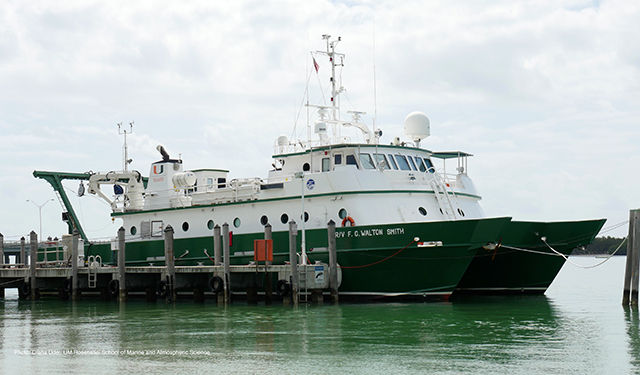
The research vessel F.G. Walton Smith is available for rent to scientists from all over the world to conduct research.

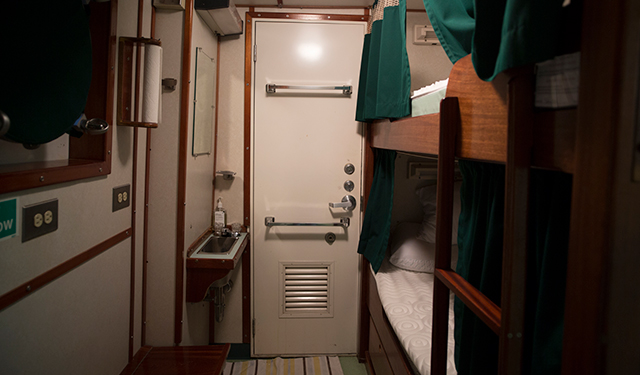

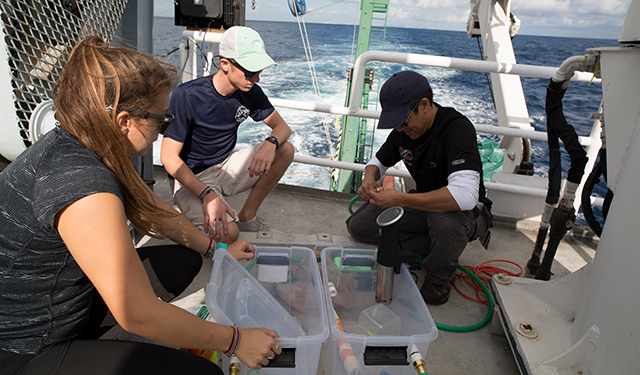

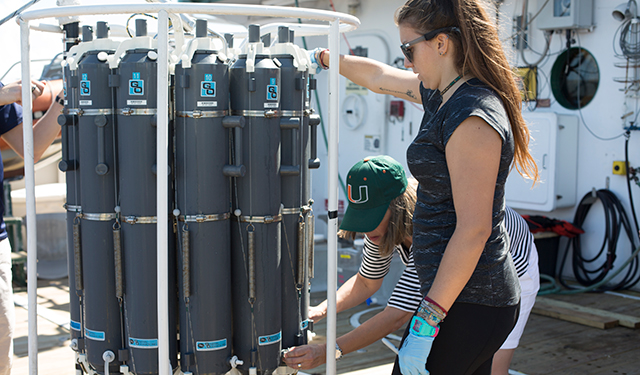
Andriana “Andi” Fragola (foreground), a Rosenstiel M.P.S. student in marine conservation, works with Lillian Custals, assistant scientist in the Department of Ocean Sciences at Rosenstiel, to test some of the water samples from the CTD (conductivity, temperature and depth) rosette.

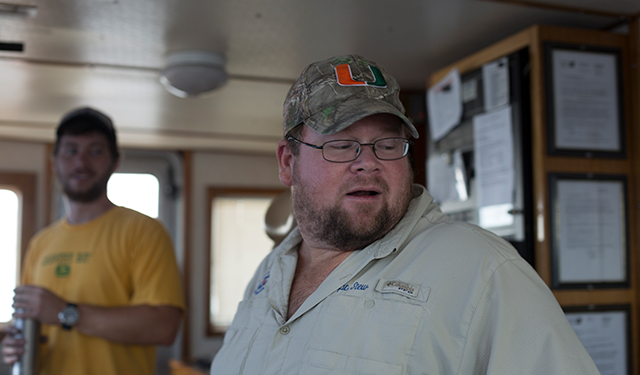
Acting Captain Stewart Bell (foreground), who was filling in for the vacationing captain, Shawn K. Lake, and Acting First Mate Kevin Jones in the wheelhouse of the F.G. Walton Smith.

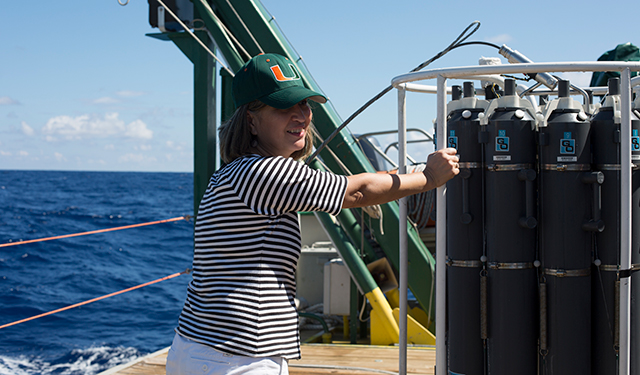
Lillian Custals, assistant scientist in the Department of Ocean Sciences at Rosenstiel, led the day’s data collection, on behalf of Dennis Hansell, on their biannual expedition collecting consensus reference material (CRM) using a CTD (conductivity, temperature and depth) rosette.

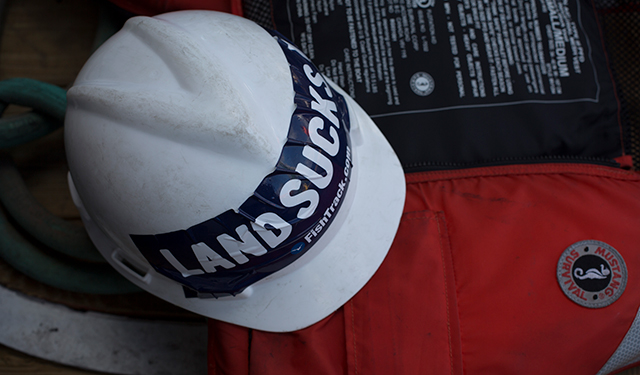
Scientists and equipment handlers must wear fluorescent floating safety vests and a hard hat when on the outdoor main deck near the bow of the F.G. Walton Smith.


Carol Mandel (foreground), the ship’s assistant engineer, and Acting First Mate Kevin Jones take a break in the mess hall after lunch.

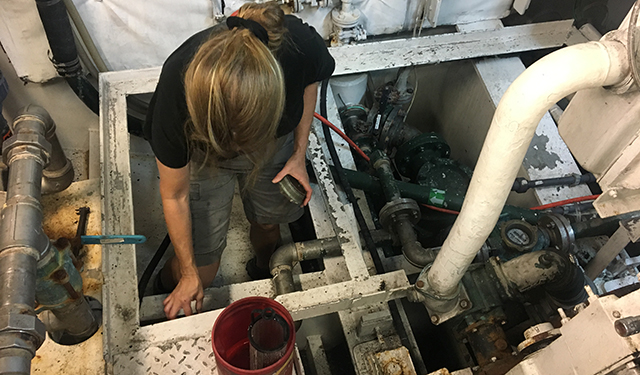
Assistant Engineer Carol Mandel strains the water that cools the engines of the F.G. Walton Smith, cleaning the removable cylinders that fill up quickly with seaweed and ocean junk.

Meanwhile, Acting Captain Stewart Bell, who was filling in for the vacationing captain, Shawn K. Lake, and Acting First Mate Kevin Jones are in constant communication with the scientists, moving from the bridge on the upper deck to the main outdoor deck. They ensure the researchers are reaching their intended cast sites and collecting the water samples and data they need.
Jones joined the Rosenstiel marine operations team in January 2017 after graduating from Texas A&M University in August 2016 and earning his license in marine operations, followed by a short stint operating a ferry in his home state of Rhode Island. Bell, who also joined the crew last January, said he rose to first mate the old-fashioned way, starting as a ship’s cook and working his way up over the past 17 years.
On the main deck, clambering in and out of the engine room, Mike Shoup, the ship’s chief engineer, and Carol Mandel, the assistant engineer, are making sure the vessel’s engines are staying cool and running smoothly. Throughout the expedition, the engineers must strain the water that cools the engines, cleaning the removable cylinders that fill up quickly with seaweed and indiscriminate sea junk.
In the galley, chef Randal Hughes has whipped up a delicious afternoon snack of almond croissants and is preparing the day’s third and final meal: tabbouleh salad, barbecue chicken, and a Mexican feast of tostadas with refried beans, ground beef with melted cheese, guacamole, tomato salsa, rice and vegetables. The almond croissants and some ginger ale help a few of the sea sick guests quell their queasiness from the 4- to 6-foot seas. But the rough ride barely fazes the crew.
“The ship can hold up to 50,000 pounds and is very stable,” Bell said, with a shrug.
“We’re sailing at about 10 knots now, which is not very fast,” added Mandel, who’s been sailing for many years, including on speed-racing sailboats. “The fastest I’ve ever gone was on a 55-foot sailboat going 18 knots.”
The F.G. Walton Smith, which can sail without refueling for up to two weeks and can desalinize seawater for an endless supply of drinking water, rents out its services to scientists from all over the world, but Behn said, “purely in the name of science.”

“The research must be for the sake of contributing to science, not for commercial or profit-making reasons.”
Just this year, the ship will sail researchers from Rosenstiel, the University of Southampton in the United Kingdom and the National Science Foundation, exploring a host of oceanographic questions.
Also, scientists from the University of Buffalo and the University of Mississippi spent two weeks in late November and early December, respectively, aboard the Walton Smith to study the impact of hurricanes Irma and Maria on coral reefs in the U.S. Virgin Islands. As a shallow water vessel, the Walton Smith makes it possible for the researchers to navigate into shallow bays and areas to deploy three small boats that carry divers to the dive sites.
From the wheelhouse, Bell steers the F.G. Walton Smith toward the sprawling Miami coastline through Government Cut, with South Beach on the starboard side and Fisher Island on the port side, and the glittering downtown skyline straight ahead. Mandel strains the cooling water for the ship’s engines, stopping every now and then to take in the magnificent view. Jones prepares the anchor, Hughes adds the final garnishes for dinner, Ilias walks the main deck, and Shoup readies himself for his nightly swim in Bear Cut along Virginia Key.
With the sun setting and a cool breeze stirring, the ship docks at the picturesque Rosenstiel campus, and the scientists, guests and crew disembark, windswept, sunburned and exhausted from the day’s work. But it was also a productive day of science that will help build on the understanding of ocean health.
As Rosenstiel School Dean Roni Avissar said, “the F.G. Walton Smith is essential to our multidisciplinary observations and sampling of the ocean to address issues related to ocean circulation, climate studies, natural hazards, human health and marine ecosystems, and to providing a best-in-class marine science education program for our undergraduate and graduate students.”
Gathering their gear and steadying their sea legs, the researchers lug their containers of data up to the lab, but not before soaking in the breathtaking views of Biscayne Bay at dusk.
Copyright: 2025 University of Miami. All Rights Reserved.
Emergency Information
Privacy Statement & Legal Notices
Individuals with disabilities who experience any technology-based barriers accessing University websites can submit details to our online form.
